Anemometers: What They Are, The Different Types Of Anemometers, And How They Work
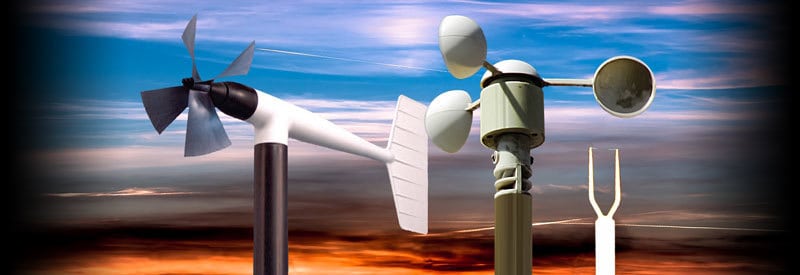
Different meteorological instruments "collaborate" with each other to determine current atmospheric conditions and make future weather predictions. One such device is known as the anemometer.
An anemometer is a meteorological instrument used to measure wind speed or the rate of airflow in the atmosphere. It forms an essential part of a weather station to help determine current and forecast future atmospheric conditions. The most widely used anemometer is known as a cup anemometer.
Even though the basic design did not change much since its invention more than 500 years ago, no significant weather station setup is complete without an anemometer, from the home weather station to professional systems used by national meteorological agencies.
In this post, we examine what an anemometer is, how it works, as well as having a look at the different types of instruments.
What Is An Anemometer?
As with any other meteorological instrument or weather event, it's important to define what an anemometer is before we examine it further:
Anemometer Definition
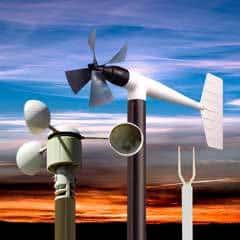
An anemometer is a meteorological instrument used to measure wind speed or rate of airflow in the atmosphere. It forms an essential part of a weather station to determine current and forecasting future atmospheric conditions. The most widely used anemometer is known as a cup anemometer.
Leon Battista Alberti developed the first anemometer in 1450. Since then, the original design was improved upon several times, but the fundamental principles remain the same.
Today, several different anemometers exist to suit specific needs or preferences. We discuss the three most significant types of anemometers and how they work in the next section.
The Types Of Anemometers And How They Work
They come in different shapes and sizes, but anemometers can be narrowed down into three types of devices:
- Cup Anemometers
- Vane Anemometers
- Hot-Wire Anemometers
Each anemometer will be separately described and examined to get a clear understanding of how each device works.
1) Cup Anemometers
A cup anemometer consists of 3-4 cylindrical cups on horizontal arms rotating around a central axis. It is connected to and drives a shaft inside the axis that starts to turn as the cups start spinning.
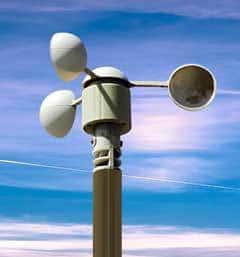
As the wind speed increases, the cups spin faster, which results in the shaft rotating more quickly as well. The number of rotations is counted, which is used to calculate the wind speed, and then gets displayed on a calibrated analog or digital wind speed meter.
For the most accurate readings, a cup anemometer must be installed approximately 10 meters (32.8 feet) above the ground in an open area. Placing it close to large objects that will influence airflow can lead to false readings.
2) Vane Anemometers
Vane anemometers, also known as propeller or windmill anemometer, also make use of wind speed to rotate. Unlike cup anemometers, though, they use blades to rotate and is also horizontally mounted (as opposed to vertically mounted cup anemometers).
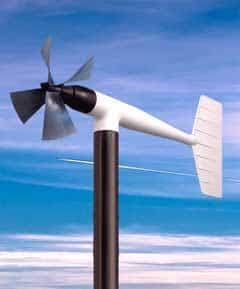
The shaft that connects to the blades is also mounted in a horizontal position, parallel to the airflow. Like the cup anemometer, the rotating blades make the shaft turn, and the number of rotations is counted to calculate the wind speed.
The blades of a vane anemometer are in the shape of an airplane propeller (hence the propeller analogy) and also react in the same way to wind movement. This is the reason it must be mounted horizontally to operate correctly and make accurate measurements.
Crucially, the blades must also face directly into the wind to perform accurate readings. To ensure this positioning, the anemometer's body rotates freely on an axis, with a vane fixed on the opposite side of the blades. The vane forces the body to turn into and face the wind.
Vane anemometers have several advantages and increased in popularity as a result. Some benefits include the ability to be used outdoors and indoors. They can also be compact and used in handheld devices and measure other atmospheric parameters besides wind speed.
3) Hot-Wire Anemometers
Unlike cup and vane anemometers which are mechanical devices, a hot-wire anemometer (also known as constant current anemometers) uses electricity and heat to measure and calculate wind speed.
It uses electricity to heat a thin wire suspended in the air. As the wind cools the wire down, the rate at which it cools down gets measured to calculate the wind speed.
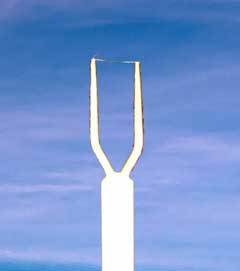
Using this method to calculate wind speed is possible since a metal's temperature directly influences its ability to conduct electricity (its resistance). A hot metal has a high resistance and does not conduct an electrical current as well as a cold metal with much less resistance.
As the heated wire starts to cool down while air passes over it, the resistance begins to decrease as well. The wind speed is calculated by measuring the rate at which the resistance in the wire decreases.
Hot-wire anemometers also have several other benefits. They can be used in more applications than just the field of meteorology. They can be used to measure gas flow in pipes and also be used in fluids to measure the flow rate of a liquid.
Since hot-wire anemometers are very sensitive to slight changes, they are particularly accurate at measuring very low wind speeds. This capability makes them important for use in environments where the slightest air movement is of importance.
These three types of anemometers can be considered to be the most relevant wind measuring devices in meteorology. They are by no means the only anemometers in existence, though.
Laser Doppler anemometers use lasers, as the name suggests. Ultrasonic anemometers utilize sound waves. And plate anemometers are used to measure high wind speeds.
The examples mentioned above are just a few examples of a broader range of anemometers also available.
Conclusion
As the article illustrated, anemometers are used to measure wind speed. However, they can be used in other applications as well. There are also several different types of anemometers, of which the three most relevant ones were highlighted.
By now, you should have a good understanding of what an anemometer is, what it is used for, and how the different types of anemometers work.
If you like to be informed whenever a new article is released, and also receive helpful tips & information, you can stay updated by simply following this link .
Until next time, keep your eye on the weather!

